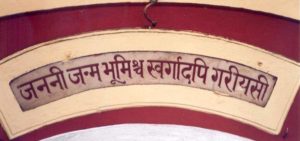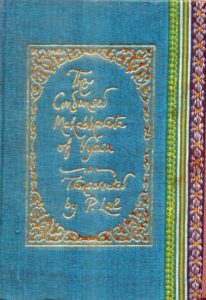In Anand Math, just before the remarkable passage in chapter 10 about ‘Mother as she was, Mother as she has become and Mother as she will be’, the protagonist Mohendra is astonished with the song ‘Bande Mataram’ and asks the sanyasi Bhavananda “What Mother?…That is the country, it is not the Mother”. Bhavananda replies that the only mother theSantans know is the motherland because, he quotes in Sanskrit, janani janmabhumishca svargadapi gariyasi‘mother and motherland are greater by far than even heaven. Here is the passage translated by Sri Aurobindo in chapter 10:
‘Bhavananda replied, “We recognize no other Mother. Mother and Motherland is more than heaven itself.”‘
I was intrigued by the half-shloka because I could not find it in any Sanskrit work readily to hand. And so began my search. My first port of call was the Bharatiya Sanskriti Kosh compiled painstakingly by Shri Liladhar Sharma ‘Parvatiya’ of Lucknow. Not finding it here, I wrote to him. The octogenarian freedom fighter responded that he, too, had no idea about its origins but had heard from people that Pandit Madan Mohan Malaviya might be its author! What an anachronism!
Next I turned to the internet and the search engines threw up the Bharatiya Vidya Bhavan website where a message by Swami Ranganathananda for the Rama Navami number of Bhavan’s Journal was reproduced. Here the venerable Swami exhorts: ‘We in India today need to be inspired by this important utterance of Sri Rama:Janani janmabhumisca svargadapi gariyasi – ‘Mother and Motherland are far superior to heaven’.*
Eagerly I e-mailed the Journal asking for chapter and verse from the Ramayanabecause I was unable to locate it in my edition of the epic. The reply I received was very interesting. They said that troubling the venerable Swami was out of the question and they were short-handed for scholars to hunt through the epic, but they would try. Nothing came of their efforts.
So I turned to a disciple of the Ramakrishna Mission, requesting that the Swamiji’s secretary be approached. The feedback was even curiouser. They virtually disowned what the Journal had published, because the material had never been cross-checked with them before publication!
Wondering what to do, I asked two scientists’a Tamilian mathematician, Professor Bhanu Murthy and a Malayalee nuclear physicist Dr. A. Harindranath’who were deeply immersed in Indian scriptures. Both of them were very familiar with the entire shloka and quoted it trippingly off the tongue. Apparently, in South India this is well known to Sanskrit school-teachers, all of whom say it is from the Ramayana and spoken by Rama in response to Vibhishana’s request that he should rule golden Lanka instead of returning to Ayodhya. I scoured the Adhyatma Ramayana, the Yoga Vashishtha Ramayana and enquired of the translator of the online Ananda Ramayana, all with no success.
Recalling that on an earlier occasion, having drawn a blank regarding the Pancha kanya shloka, I had requested the Indology Listserver on the internet for help (this is a website where Indologists post queries for eliciting information from the community of Indological scholars), I turned to it. I received a response from Professor Jan E.M. Houben of Holland who wrote, “I have the strong impression that jananii janmabhuumis ca svargaad api gariiyasii was a quotation, but it seemed to me part of the novel…Note that also the idea of Indian nationalism which was instrumental for the liberation of India was newly emerging in Bankimchand’s time. Both the idea and the expression are new, that’s why you don’t find an earlier source. For Shankara at least jananii was not so sacred: punar api jananam, punar api jananiija.thare ;sayanam, iha sa.msaare bahudustaare k.rpayaa’paare paahi muraare! An article on the emergence of Indian nationalism and Bankimchand’s role in it appeared in a book I edited (Ideology and Status of Sanskrit, Leiden: Brill, 1996), it was by V.A. van Bijlert. Jananii janmabhuumi;s ca svargaad api gariiyasii, is of course half (2×8 syllables) of a shloka; even then the formulation and the idea expressed seem to be new and suiting to the specific context of Bankimchand.”
But, if this be so, how was it so well known in the deep South and invariably attributed to Rama? Also, if Bankim had not composed it but had used something that was current in the public memory, why did it not occur anywhere in the Gaudiya recension of the Valmiki Ramayana?
Hearing that the famous Vamadeva (David Frawley) was in India, I tried to get in touch with him through N.S. Rajaram who told me that the epics were not Frawley’s forte. He added that he had memories of hearing this shloka in a Hanuman Natakamperformance. I checked Camille Bulcke’s monumental Ramkatha: Utapatti aur Vikasfor this, and found no reference to the shloka in the entries on Hanuman Natakamor, for that matter, elsewhere.
In the meantime I met Professor Julius Lipner of Cambridge University, who was completing a new translation of Ananda Math but had never seen Sri Aurobindo and Barindra Ghosh’s translation of the novel in the early decades of the 20th century. I provided him with a copy and arranged for his visit to Lalgola in Murshidabad district to see the image of Durga-Kali that had inspired Bankim’s vision of the mother-as-she-has-become. I put the problem to him, but he had not a clue. On his return to England he took the trouble of getting in touch with several scholars including Prof. J.L. Brockington of Edinburgh University who has studied the epic verse-by-verse (cf. my review of his Epic Threads). Professor Lipner writes, ‘They all say that this verse is not in any edition of the Ramayana known to them! Folklore.’ But, he added, had I noticed that the half-shloka was engraved on one of the entrances to the Dakshineshwar Kali temple? Now, that was something none of us, who visit the temple so often, have noticed. Rani Rasmoni, the fiercely independent zamindar, had completed this temple in 1855, several years before Ananda Math was written. Shri Kushal Chowdhury, trustee of the temple, informed me that Bankimchandra was known to have visited the Rani and would certainly have come to see this marvellous navaratna temple dedicated to Mother Kali. The question he could not answer is: was it the Rani who had this half-shloka engraved? Whose idea was it and from where were the words taken?
I now turned to Professor Sushil Mittal, editor of the International Journal of Hindu Studies and co-author of the encyclopaedic Hindu World project. He circulated my query to some prominent scholars. Here is the reply he received from Robert Goldman, editor of the English translation of the critical text of the Ramayana: ‘As I have seen the verse, it is apparent that it is from a version of the Ramayana story. Rama, it appears, utters the verse to Lakshmana at some point, probably in theYuddhakanda. The full verse runs:
Api svarnamayi lanka na me lakshmana rocate/
Janani janmabhumish casvargad api gariyasi//I do not care for Lanka, Lakshmana, even though it be made of gold.
One’s mother and one’s native land are worth more even than heaven.’
Professor Goldman added, ‘but I am not really sure, off the top of my head, what the exact textual source is’I would suggest checking other Sanskrit versions such as theAnanda Ramayana, Kshemendra’s Ramayanamanjari, Campuramayana etc.’ As already stated, it is not to be found in the Ananda Ramayana. I do not have access to the others, but Bulcke’s study does not mention the shloka occurring in any version of the epic. Professor Jayant Bapat informed Dr. Mittal that he located the identical shloka ‘in a Marathi book called Marathi Bhashechi Sanskrit Leni (Sanskrit ornaments in the Marathi language).’ He adds, ‘The author does not specify where he got it from and says that the source is unknown.’
My argument is that as neither of our epics show evidence of any concept of a motherland, this attribution of the saying to Rama is anachronistic and apocryphal. Is it then a folk-memory of an anonymously composed masterpiece of a shloka born of patriotic fervour’something like the elusive Pancha kanya shloka? 

 The Condensed Mahabharata of Vyasa by P. Lal, First published 1980, 3rd edn 2010 (Revised and Corrected) Price: HB Rs 600, FB Rs 400
The Condensed Mahabharata of Vyasa by P. Lal, First published 1980, 3rd edn 2010 (Revised and Corrected) Price: HB Rs 600, FB Rs 400